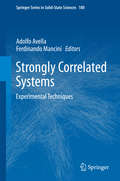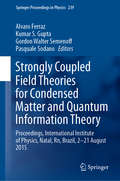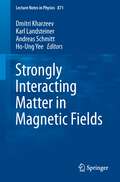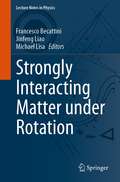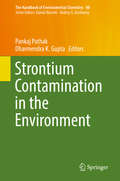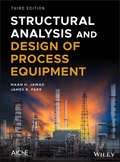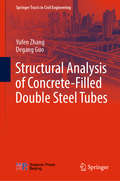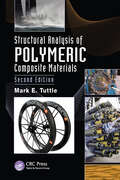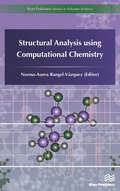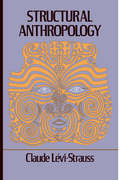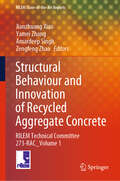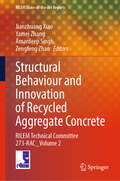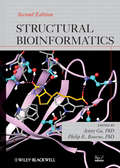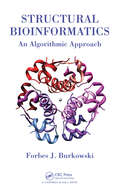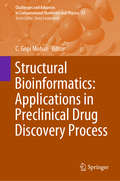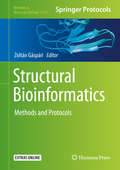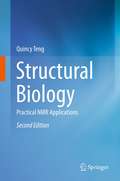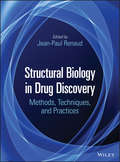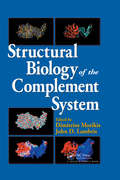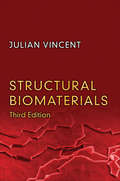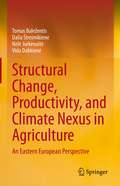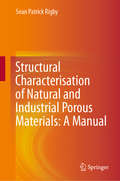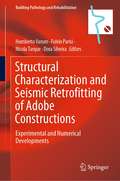- Table View
- List View
Strongly Correlated Systems
by Ferdinando Mancini Adolfo AvellaThis volume presents, for the very first time, an exhaustive collection of those modern numerical methods specifically tailored for the analysis of Strongly Correlated Systems. Many novel materials, with functional properties emerging from macroscopic quantum behaviors at the frontier of modern research in physics, chemistry and material science, belong to this class of systems. Any technique is presented in great detail by its own inventor or by one of the world-wide recognized main contributors. The exposition has a clear pedagogical cut and fully reports on the most relevant case study where the specific technique showed to be very successful in describing and enlightening the puzzling physics of a particular strongly correlated system. The book is intended for advanced graduate students and post-docs in the field as textbook and/or main reference, but also for other researchers in the field who appreciate consulting a single, but comprehensive, source or wishes to get acquainted, in a as painless as possible way, with the working details of a specific technique.
Strongly Coupled Field Theories for Condensed Matter and Quantum Information Theory: Proceedings, International Institute of Physics, Natal, Rn, Brazil, 2–21 August 2015 (Springer Proceedings in Physics #239)
by Alvaro Ferraz Kumar S. Gupta Gordon Walter Semenoff Pasquale SodanoThis book presents a selection of advanced lectures from leading researchers, providing recent theoretical results on strongly coupled quantum field theories. It also analyzes their use for describing new quantum states, which are physically realizable in condensed matter, cold-atomic systems, as well as artificial materials. It particularly focuses on the engineering of these states in quantum devices and novel materials useful for quantum information processing. The book offers graduate students and young researchers in the field of modern condensed matter theory an updated review of the most relevant theoretical methods used in strongly coupled field theory and string theory. It also provides the tools for understanding their relevance in describing the emergence of new quantum states in a variety of physical settings. Specifically, this proceedings book summarizes new and previously unrelated developments in modern condensed matter physics, in particular: the interface of condensed matter theory and quantum information theory; the interface of condensed matter physics and the mathematics emerging from the classification of the topological phases of matter, such as topological insulators and topological superconductors; and the simulation of condensed matter systems with cold atoms in optical lattices.
Strongly Interacting Matter in Magnetic Fields
by Karl Landsteiner Andreas Schmitt Dmitri Kharzeev Ho-Ung YeeThe physics of strongly interacting matter in an external magnetic field is presently emerging as a topic of great cross-disciplinary interest for particle, nuclear, astro- and condensed matter physicists. It is known that strong magnetic fields are created in heavy ion collisions, an insight that has made it possible to study a variety of surprising and intriguing phenomena that emerge from the interplay of quantum anomalies, the topology of non-Abelian gauge fields, and the magnetic field. In particular, the non-trivial topological configurations of the gluon field induce a non-dissipative electric current in the presence of a magnetic field. These phenomena have led to an extended formulation of relativistic hydrodynamics, called chiral magnetohydrodynamics. Hitherto unexpected applications in condensed matter physics include graphene and topological insulators. Other fields of application include astrophysics, where strong magnetic fields exist in magnetars and pulsars. Last but not least, an important new theoretical tool that will be revisited and which made much of the progress surveyed in this book possible is the holographic principle - the correspondence between quantum field theory and gravity in extra dimensions. Edited and authored by the pioneers and leading experts in this newly emerging field, this book offers a valuable resource for a broad community of physicists and graduate students.
Strongly Interacting Matter under Rotation (Lecture Notes in Physics #987)
by Francesco Becattini Jinfeng Liao Michael LisaThis book addresses the needs of growing community of graduate students and researchers new to the area, for a survey that covers a wide range of pertinent topics, summarizes the current status of the field, and provides the necessary pedagogical materials for newcomers. The investigation of strongly interacting matter under the influence of macroscopic rotational motion is a new, emerging area of research that encompasses a broad range of conventional physics disciplines such as nuclear physics, astrophysics, and condensed matter physics, where the non-trivial interplay between global rotation and spin is generating many novel phenomena. Edited and authored by leading researchers in the field, this book covers the following topics: thermodynamics and equilibrium distribution of rotating matter; quantum field theory and rotation; phase structure of QCD matter under rotation; kinetic theory of relativistic rotating matter; hydrodynamics with spin; magnetic effects in fluid systems with high vorticity and charge; polarization measurements in heavy ion collisions; hydrodynamic modeling of the QCD plasma and polarization calculation in relativistic heavy ion collisions; chiral vortical effect; rotational effects and related topics in neutron stars and condensed matter systems.
Strongly Nonlinear Oscillators
by Livija CveticaninThis book provides the presentation of the motion of pure nonlinear oscillatory systems and various solution procedures which give the approximate solutions of the strong nonlinear oscillator equations. The book presents the original author's method for the analytical solution procedure of the pure nonlinear oscillator system. After an introduction, the physical explanation of the pure nonlinearity and of the pure nonlinear oscillator is given. The analytical solution for free and forced vibrations of the one-degree-of-freedom strong nonlinear system with constant and time variable parameter is considered. Special attention is given to the one and two mass oscillatory systems with two-degrees-of-freedom. The criteria for the deterministic chaos in ideal and non-ideal pure nonlinear oscillators are derived analytically. The method for suppressing chaos is developed. Important problems are discussed in didactic exercises. The book is self-consistent and suitable as a textbook for students and also for professionals and engineers who apply these techniques to the field of nonlinear oscillations.
Strontium Contamination in the Environment (The Handbook of Environmental Chemistry #88)
by Dharmendra K. Gupta Pankaj PathakThis book provides an authoritative review of the origin and extraction of strontium and its impact on the environment. It also presents the latest strontium decontamination and remediation strategies. Around the globe, nuclear power is being recognized as a major source of energy and is expected to play a crucial role in meeting the energy requirements of present day society. However, the pros and cons have to be considered, and the safe disposal of large amounts of radionuclide wastes is becoming a matter of great concern. These wastes encompass contaminants such as heavy metals and toxic substances, which may exist in solid, liquid or gaseous forms or a combination of these, and as such, their disposal requires particular attention. The book focuses on 90Sr, which is a predominant isotope of strontium and considered an intermediate level radioactive waste with a half-life of 28.8 years, average biological half-life of 18 years and 546 KeV decay energy. Written by expert contributors, it addresses occurrence, detection and extraction of strontium, the chemical and nuclear properties of strontium isotopes, the fate and migration of strontium in soil, its bioaccumulation, and its associated health impact, mechanistic toxicity response as well as related regulation and remediation. It appeals to scholars, scientists and environmental managers working with strontium contamination in the environment and its consequences.
Structural Analysis and Design of Process Equipment
by James R. Farr Maan H. JawadStill the only book offering comprehensive coverage of the analysis and design of both API equipment and ASME pressure vessels This edition of the classic guide to the analysis and design of process equipment has been thoroughly updated to reflect current practices as well as the latest ASME Codes and API standards. In addition to covering the code requirements governing the design of process equipment, the book supplies structural, mechanical, and chemical engineers with expert guidance to the analysis and design of storage tanks, pressure vessels, boilers, heat exchangers, and related process equipment and its associated external and internal components. The use of process equipment, such as storage tanks, pressure vessels, and heat exchangers has expanded considerably over the last few decades in both the petroleum and chemical industries. The extremely high pressures and temperatures involved with the processes for which the equipment is designed makes it potentially very dangerous to property and life if the equipment is not designed and manufactured to an exacting standard. Accordingly, codes and standards such as the ASME and API were written to assure safety. Still the only guide covering the design of both API equipment and ASME pressure vessels, Structural Analysis and Design of Process Equipment, 3rd Edition: Covers the design of rectangular vessels with various side thicknesses and updated equations for the design of heat exchangers Now includes numerical vibration analysis needed for earthquake evaluation Relates the requirements of the ASME codes to international standards Describes, in detail, the background and assumptions made in deriving many design equations underpinning the ASME and API standards Includes methods for designing components that are not covered in either the API or ASME, including ring girders, leg supports, and internal components Contains procedures for calculating thermal stresses and discontinuity analysis of various components Structural Analysis and Design of Process Equipment, 3rd Edition is an indispensable tool-of-the-trade for mechanical engineers and chemical engineers working in the petroleum and chemical industries, manufacturing, as well as plant engineers in need of a reference for process equipment in power plants, petrochemical facilities, and nuclear facilities.
Structural Analysis in the Social Sciences: Illuminating Dark Networks
by Luke M. GerdesSome of the most important international security threats stem from terror groups, criminal enterprises, and other violent non-state actors (VNSAs). Because these groups are often structured as complex, dark networks, analysts have begun to use network science to study them. However, standard network tools were originally developed to examine companies, friendship groups, and other transparent networks. The inherently clandestine nature of dark networks dictates that conventional analytical tools do not always apply. Data on dark networks is incomplete, inaccurate, and often just difficult to find. Moreover, dark networks are often organized to undertake fundamentally different tasks than transparent networks, so resources and information may follow different paths through these two types of organizations. Given the distinctive characteristics of dark networks, unique tools and methods are needed to understand these structures. Illuminating Dark Networks explores the state of the art in methods to study and understand dark networks.
Structural Analysis of Concrete-Filled Double Steel Tubes (Springer Tracts in Civil Engineering)
by Yufen Zhang Degang GuoThis book offers a clear and comprehensive overview of both the theory and application of fundamental aspects of concrete-filled double steel tubes (CFDST). Many analysis and design applications are presented, which involve mechanical components and structural members often encountered in engineering practice. This monograph is written for practicing structural and civil engineers, students, and academic researchers who want to keep up to speed on the latest technologies for concrete-filled steel tube (CFST).
Structural Analysis of Polymeric Composite Materials
by Mark E. TuttleStructural Analysis of Polymeric Composite Materials, Second Edition introduces the mechanics of composite materials and structures and combines classical lamination theory with macromechanical failure principles for prediction and optimization of composite structural performance. It addresses topics such as high-strength fibers, manufacturing tech
Structural Analysis using Computational Chemistry
by Norma-Aurea Rangel-VázquezComputational chemistry is a science that allows researchers to study, characterize and predict the structure and stability of chemical systems. In other words: studying energy differences between different states to explain spectroscopic properties and reaction mechanisms at the atomic level. This field is gaining in relevance and strength due to field applications from chemical engineering, electrical engineering, electronics, biomedicine, biology, materials science, to name but a few. Structural Analysis using Computational Chemistry arises from the need to present the progress of computational chemistry in various application areas. Technical topics discussed in the book include: • Quantum mechanics and structural molecular study (AM1)• Application of quantum models in molecular analysis• Molecular analysis of insulin through controlled adsorption in hydrogels based on chitosan• Analysis and molecular characterization of organic materials for application in solar cells• Determination of thermodynamic properties of ionic liquids through molecular simulation
Structural Anthropology
by Claude Levi-StraussThe "structural method," first set forth in this epoch-making book, changed the very face of social anthropology. This reissue of a classic will reintroduce readers to Lévi-Strauss's understanding of man and society in terms of individuals--kinship, social organization, religion, mythology, and art.
Structural Behaviour and Innovation of Recycled Aggregate Concrete: RILEM Technical Committee 273-RAC _ Volume 1 (RILEM State-of-the-Art Reports #41)
by Jianzhuang Xiao Amardeep Singh Yamei Zhang Zengfeng ZhaoThis book presents the work of the RILEM Technical Committee 273-RAC on Structural Behaviour and Innovation of Recycled Aggregate Concrete. It provides the guidelines on the changes in the properties of recycled aggregates and how the different countries manage the use of recycled aggregates in construction work. As such, it helps researchers understand some new technologies to improve the qualities of RAC and the enhancement of RAC. Various mixing approaches adopted by the mixing approach, mixture proportioning for RAC using Compressible Packing Model, Particle Packing Method of mix proportioning for RAC and a rational mix design method for RAC are proposed. Further evaluation of the stress-strain relationship and bond behavior of RAC is explored in these guidelines. The current volume focuses on "Material Properties".
Structural Behaviour and Innovation of Recycled Aggregate Concrete: RILEM Technical Committee 273-RAC_Volume 2 (RILEM State-of-the-Art Reports #42)
by Jianzhuang Xiao Amardeep Singh Yamei Zhang Zengfeng ZhaoThis book presents the work of the RILEM Technical Committee 273-RAC on Structural Behaviour and Innovation of Recycled Aggregate Concrete. It provides the guidelines on the changes in the properties of recycled aggregates and how the different countries manage the use of recycled aggregates in construction work. As such, it helps researchers understand some new technologies to improve the qualities of RAC and the enhancement of RAC. Various mixing approaches adopted by the mixing approach, mixture proportioning for RAC using compressible packing model, particle packing method of mix proportioning for RAC, and a rational mix design method for RAC are proposed. Further evaluation of the stress-strain relationship and bond behaviour of RAC is explored in these guidelines. The current book focuses on "Structural Performance with RAC" and “Codes and Guidelines”. Feel free to contact me with any questions. We are looking forward to hearing from you.
Structural Bioinformatics
by Philip E. Bourne Jenny GuStructural Bioinformatics was the first major effort to show the application of the principles and basic knowledge of the larger field of bioinformatics to questions focusing on macromolecular structure, such as the prediction of protein structure and how proteins carry out cellular functions, and how the application of bioinformatics to these life science issues can improve healthcare by accelerating drug discovery and development. Designed primarily as a reference, the first edition nevertheless saw widespread use as a textbook in graduate and undergraduate university courses dealing with the theories and associated algorithms, resources, and tools used in the analysis, prediction, and theoretical underpinnings of DNA, RNA, and proteins.This new edition contains not only thorough updates of the advances in structural bioinformatics since publication of the first edition, but also features eleven new chapters dealing with frontier areas of high scientific impact, including: sampling and search techniques; use of mass spectrometry; genome functional annotation; and much more.Offering detailed coverage for practitioners while remaining accessible to the novice, Structural Bioinformatics, Second Edition is a valuable resource and an excellent textbook for a range of readers in the bioinformatics and advanced biology fields.Praise for the previous edition:"This book is a gold mine of fundamental and practical information in an area not previously well represented in book form."--Biochemistry and Molecular Education"... destined to become a classic reference work for workers at all levels in structural bioinformatics...recommended with great enthusiasm for educators, researchers, and graduate students."--BAMBED"...a useful and timely summary of a rapidly expanding field."--Nature Structural Biology"...a terrific job in this timely creation of a compilation of articles that appropriately addresses this issue."--Briefings in Bioinformatics
Structural Bioinformatics: An Algorithmic Approach (Chapman & Hall/CRC Computational Biology Series)
by Forbes J. BurkowskiThe Beauty of Protein Structures and the Mathematics behind Structural BioinformaticsProviding the framework for a one-semester undergraduate course, Structural Bioinformatics: An Algorithmic Approach shows how to apply key algorithms to solve problems related to macromolecular structure.Helps Students Go Further in Their Study of Structural Biolog
Structural Bioinformatics: Applications in Preclinical Drug Discovery Process (Challenges and Advances in Computational Chemistry and Physics #27)
by C. Gopi MohanThis book reviews the advances and challenges of structure-based drug design in the preclinical drug discovery process, addressing various diseases, including malaria, tuberculosis and cancer. Written by internationally recognized researchers, this edited book discusses how the application of the various in-silico techniques, such as molecular docking, virtual screening, pharmacophore modeling, molecular dynamics simulations, and residue interaction networks offers insights into pharmacologically active novel molecular entities. <P><P> It presents a clear concept of the molecular mechanism of different drug targets and explores methods to help understand drug resistance. In addition, it includes chapters dedicated to natural-product- derived medicines, combinatorial drug discovery, the CryoEM technique for structure-based drug design and big data in drug discovery. <P><P> The book offers an invaluable resource for graduate and postgraduate students, as well as for researchers in academic and industrial laboratories working in the areas of chemoinformatics, medicinal and pharmaceutical chemistry and pharmacoinformatics.
Structural Bioinformatics: Methods and Protocols (Methods in Molecular Biology #2112)
by Zoltán GáspáriThis volume looks at the latest techniques used to perform comparative structure analyses, and predict and evaluate protein-ligand interactions. The chapters in this book cover tools and servers such as LiteMol; Bio3D-Web; DALI; CATH; HoTMuSiC, a contact-base protein structure analysis tool known as CAD-Score; PyDockSaxs and HADDOCK; CombDock and DockStar; the BioMagResBank database; as well as BME and CoNSEnsX+. Written in the highly successful Methods in Molecular Biology series format, chapters include introductions to their respective topics, step-by-step, readily reproducible computational protocols, and tips on troubleshooting and avoiding known pitfalls.Cutting-edge and comprehensive, Structural Bioinformatics: Methods and Protocols is a practical guide for researchers to learn more about the aforementioned tools to further enhance their studies in the growing field of structural bioinformatics.Chapter 13 is available open access under a CC-BY 4.0 license via link.springer.com.
Structural Biology
by Quincy TengThis 2nd edition begins with an overview of NMR development and applications in biological systems. It describes recent developments in instrument hardware and methodology. Chapters highlight the scope and limitation of NMR methods. While detailed math and quantum mechanics dealing with NMR theory have been addressed in several well-known NMR volumes, chapter two of this volume illustrates the fundamental principles and concepts of NMR spectroscopy in a more descriptive manner. Topics such as instrument setup, data acquisition, and data processing using a variety of offline software are discussed. Chapters further discuss several routine stategies for preparing samples, especially for macromolecules and complexes. The target market for such a volume includes researchers in the field of biochemistry, chemistry, structural biology and biophysics.
Structural Biology in Drug Discovery: Methods, Techniques, and Practices
by Jean-Paul RenaudWith the most comprehensive and up-to-date overview of structure-based drug discovery covering both experimental and computational approaches, Structural Biology in Drug Discovery: Methods, Techniques, and Practices describes principles, methods, applications, and emerging paradigms of structural biology as a tool for more efficient drug development. Coverage includes successful examples, academic and industry insights, novel concepts, and advances in a rapidly evolving field.The combined chapters, by authors writing from the frontlines of structural biology and drug discovery, give readers a valuable reference and resource that: Presents the benefits, limitations, and potentiality of major techniques in the field such as X-ray crystallography, NMR, neutron crystallography, cryo-EM, mass spectrometry and other biophysical techniques, and computational structural biology Includes detailed chapters on druggability, allostery, complementary use of thermodynamic and kinetic information, and powerful approaches such as structural chemogenomics and fragment-based drug design Emphasizes the need for the in-depth biophysical characterization of protein targets as well as of therapeutic proteins, and for a thorough quality assessment of experimental structures Illustrates advances in the field of established therapeutic targets like kinases, serine proteinases, GPCRs, and epigenetic proteins, and of more challenging ones like protein-protein interactions and intrinsically disordered proteins
Structural Biology of the Complement System
by John D. Lambris Dimitrios MorikisOf recent, the structure of the complement system has received considerable attention, including the publication of several three-dimensional structures of complement proteins. This has led to the need for an authoritative resource to provide a complete overview of the basics, as well as an explanation of the cutting-edge work being accomplished in
Structural Biomaterials: Third Edition
by Julian VincentThis is a thoroughly revised, updated, and expanded edition of a classic illustrated introduction to the structural materials in natural organisms and what we can learn from them to improve man-made technology--from nanotechnology to textiles to architecture. Julian Vincent's book has long been recognized as a standard work on the engineering design of biomaterials and is used by undergraduates, graduates, researchers, and professionals studying biology, zoology, engineering, and biologically inspired design. This third edition incorporates new developments in the field, the most important of which have been at the molecular level. All of the illustrations have been redrawn, the references have been updated, and a new chapter on biomimetic design has been added. Vincent emphasizes the mechanical properties of structural biomaterials, their contribution to the lives of organisms, and how these materials differ from man-made ones. He shows how the properties of biomaterials are derived from their chemistry and interactions, and how to measure them. Starting with proteins and polysaccharides, he shows how skin and hair function, how materials self-assemble, and how ceramics such as bone and mother-of-pearl can be so stiff and tough, despite being made in water in benign ambient conditions. Finally, he combines these topics with an analysis of how the design of biomaterials can be adapted in technology, and presents a series of guidelines for designers. An accessible illustrated introduction with minimal technical jargon Suitable for undergraduates and more advanced readers Integrates chemistry, mechanics, and biology Includes descriptions of all biological materials Simple exposition of mechanical analysis of materials
Structural Change, Productivity, and Climate Nexus in Agriculture: An Eastern European Perspective
by Dalia Štreimikienė Tomas Baležentis Nelė Jurkėnaitė Vida DabkienėThis monograph addresses the methodological and empirical issues relevant for the development of sustainable agriculture, with a particular focus on Eastern Europe. It relates economic growth to the other dimensions of sustainability by applying integrated methods. The book comprises five chapters dedicated to the theoretical approaches towards sustainable rural development, productivity analysis, structural change analysis and environmental footprint. The book focuses on the transformations of the agricultural sector while taking into account economic, environmental, and social dynamics. The importance of agricultural transformations to the livelihood of the rural population and food security are highlighted. Further, advanced methodologies and frameworks are presented to fathom the underlying trends in different facets of agricultural production. The authors present statistical methods used for the analysis of agricultural sustainability along with applications for agriculture in the European Union. Additionally, they discuss the measures of efficiency, methodological approaches and empirical models. Finally, the book applies econometric and optimization techniques, which are useful for the estimation of the production functions and other representations of technology in the case of the European Union member states. Therefore, the book is a must-read for researchers and students of agricultural and production economics, as well as policy-makers and academia in general.
Structural Characterisation of Natural and Industrial Porous Materials: A Manual
by Sean Patrick RigbyThis book focuses on structural characterisation techniques for porous materials. Covering a range of techniques, including gas sorption, mercury porosimetry, thermoporometry, NMR and imaging methods, this practical guide presents the basic theory behind each characterisation technique, and discusses the practicalities of the experimental and data analysis approaches needed for complex industrial samples. The book shows readers how to approach characterising a particular sort of material for the first time and then how to develop a strategy for more in-depth analysis. It also demonstrates how to determine the best techniques for solving particular problems, and describes methods of obtaining the required information, as well as the limitations of various methods. It particularly highlights a scientific approach involving parameter validation and simple acquisition. Featuring examples taken from case studies of real-world industrial materials, this book is intended for industrial practitioners and researchers. It provides a manual of potential techniques and answers questions concerning porous materials that arise in areas such as the catalyst industry, the oil and gas sector, batteries, fuel cells, tissue engineering scaffolds and drug delivery devices.
Structural Characterization and Seismic Retrofitting of Adobe Constructions: Experimental and Numerical Developments (Building Pathology and Rehabilitation #20)
by Humberto Varum Fulvio Parisi Nicola Tarque Dora SilveiraThis book provides the reader with a review of the most relevant research on the structural characterization and seismic retrofitting of adobe construction. It offers a complete review of the latest research developments, and hence the relevance of the field. The book starts with an introductory discussion on adobe construction and its use throughout the world over time, highlighting characteristics and performance of adobe masonry structures as well as different contributions for cultural heritage conservation (Chapter 1). Then, the seismic behaviour of adobe masonry buildings is addressed, including examples of real performance during recent earthquakes (Chapter 2). In the following chapters, key research investigations on seismic response assessment and retrofitting of adobe constructions are reviewed. The review deals with the following issues: mechanical characterization of adobe bricks and adobe masonry (Chapters 3 and 4); quasi-static and shaking table testing of adobe masonry walls and structures (Chapters 5 and 6); non-destructive and minor-destructive testing for characterization of adobe constructions (Chapter 7); seismic strengthening techniques for adobe constructions (Chapter 8); and numerical modelling of adobe structures (Chapter 9). The book ends with Chapter 10, where some general conclusions are drawn and research needs are identified. Each chapter is co-authored by a group of experts from different countries to comprehensively address all issues of adobe constructions from a worldwide perspective. The information covered in this book is fundamental to support civil engineers and architects in the rehabilitation and strengthening of existing adobe constructions and also in the design of new adobe buildings. This information is also of interest to researchers, by providing a summary of existing research and suggesting possible directions for future research efforts.
